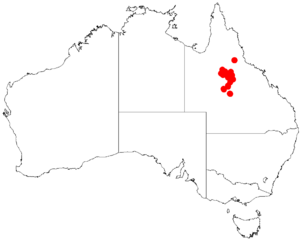Pink gidgee facts for kids
Quick facts for kids Pink gidgee |
|
|---|---|
| Conservation status | |
| Scientific classification | |
| Genus: |
Acacia
|
| Species: |
crombiei
|
 |
|
| Occurrence data from AVH | |
The Acacia crombiei, often called pink gidgee, is a type of shrub or small tree. It belongs to the Acacia family, which includes many wattle trees. You can find it growing naturally in central Queensland, Australia.
What Does Pink Gidgee Look Like?
This tree usually grows to about 10 m (33 ft) (33 feet) tall. It looks a bit like other acacia trees, such as Acacia cana or the gidgee tree (Acacia cambagei).
Its branches are smooth, meaning they are hairless. They are also a bit wavy or bent, and have angles. Unlike some plants, they do not have small leaf-like parts called stipules.
Instead of true leaves, the pink gidgee has "phyllodes." These are flattened leaf stalks that act like leaves. They are pale green and shaped like narrow lines. Each phyllode is about 10 to 15 cm (3.9 to 5.9 in) (4 to 6 inches) long and 3 to 8 mm (0.12 to 0.31 in) (0.1 to 0.3 inches) wide. They are narrower at both ends and have a clear central vein.
The tree's flowers grow in groups of one to four. Each group has round flower-heads. After the flowers bloom, long, narrow seed pods form. These pods are about 10 cm (3.9 in) (4 inches) long and 2 cm (0.79 in) (0.8 inches) wide. Inside the pods are shiny, dark-brown seeds. The seeds are flat and shaped like an oval.
Where Does Pink Gidgee Grow?
The pink gidgee grows in only a few small, separate areas. These areas are found around the town of Muttaburra in a dry part of central Queensland. You can find it as far south as Winton and stretching about 450 km (280 mi) (280 miles) north to Greenvale.
The total area where this tree grows is about 34,000 km2 (13,000 sq mi) (13,127 square miles). There are about 15 smaller groups of these trees, with an estimated total of 76,000 individual plants.
Pink gidgee usually grows in open woodlands or on grassy plains with trees. It often grows alongside other trees like Acacia cambagei and Atalaya hemiglauca. It prefers to grow in rich, fertile soils that are found over sandstone and basalt rock.
In 2008, the pink gidgee was officially listed as a Vulnerable species. This means it is at risk of becoming endangered. This listing was made under the Environment Protection and Biodiversity Conservation Act 1999, which helps protect Australia's plants and animals.


